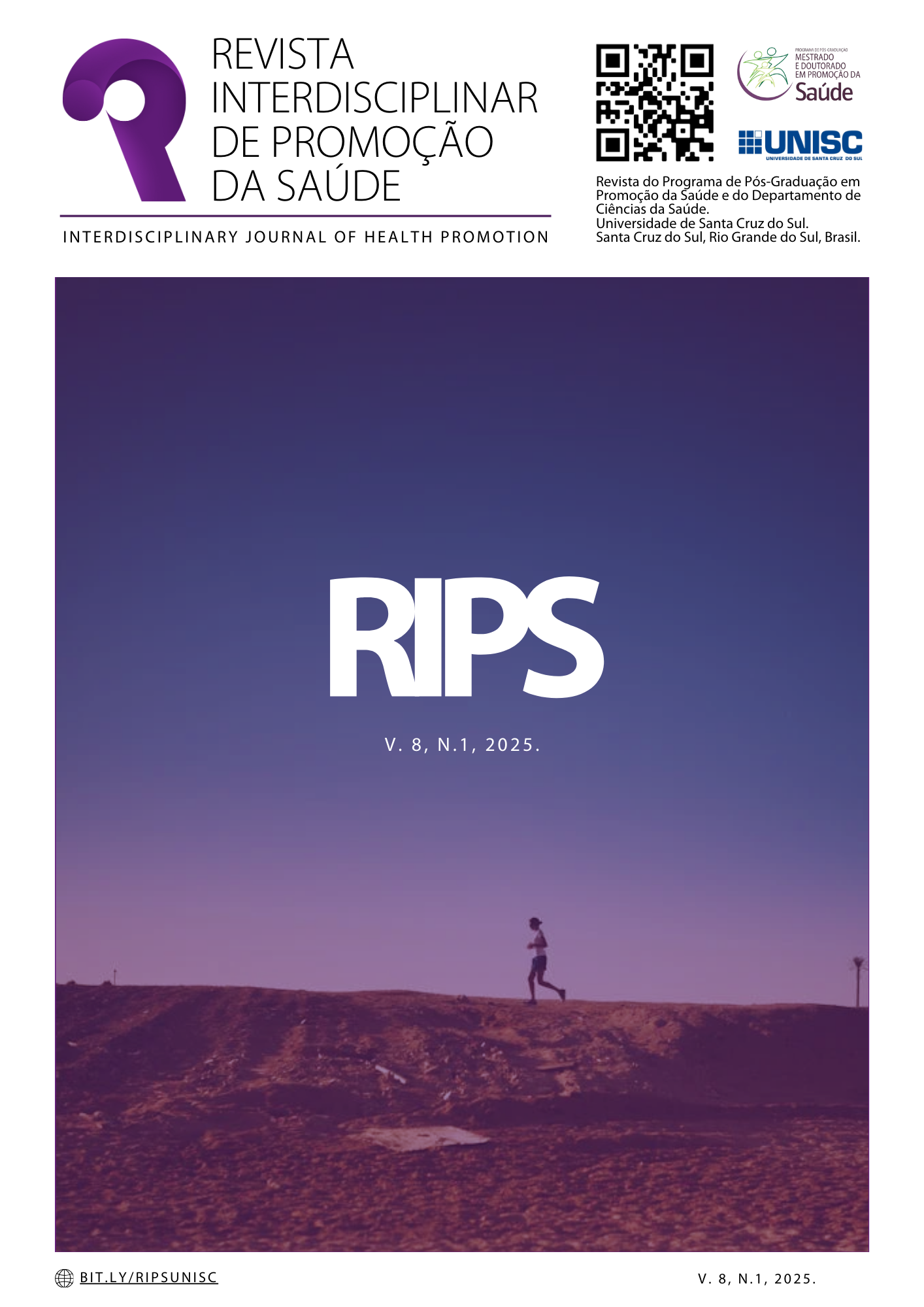PREVALENCE AND FACTORS ASSOCIATED WITH NON-PARTICIPATION IN PHYSICAL EDUCATION CLASSES IN SCHOOL ADOLESCENTS OF SERGIPE
DOI:
https://doi.org/10.17058/rips.v8i1.18938Keywords:
Motor Activity, Health, Adolescent BehaviorAbstract
Introduction: The frequency in physical education (PE) classes, beyond being low, tends to decrease with the passing of school years, suggesting an understanding of the factors for possible intervention. Objective: The objective of this study was determining the prevalence and risk factors associated with absence in PE classes. Method: In the research, 3.992 students were investigated about participation in PE classes, socioeconomic, demographic, and behavioral conditions. Results: The results revealed that 25.7% of students are absent in PE classes. Skin color, religious observance, household situation and shift study were associated with the outcome (absence in PE classes). Between girls, the outcome was associated with skin color, religious observance, situation of domicile and period of study; whereas for boys, only the situation of domicile and the period of study. Conclusion: One could conclude that the absence in PE classes is relatively high and that girls showed more associated risk factors.
Keywords: Motor Activity; Health; Adolescent Behavior.
Downloads
References
Ogden CL, Carroll MD, Curtin LR, McDowell MA, Tabak CJ, Flegal KM. Prevalence of Overweight and Obesity in the United States, 1999-2004. JAMA. 5 de abril de 2006;295(13):1549.
Cawley J, Frisvold D, Meyerhoefer C. The impact of physical education on obesity among elementary school children. J Health Econ. julho de 2013;32(4):743–55.
Chen F, Wang Y, Shan X, Cheng H, Hou D, Zhao X, et al. Association between Childhood Obesity and Metabolic Syndrome: Evidence from a Large Sample of Chinese Children and Adolescents. PLoS One. 17 de outubro de 2012;7(10):e47380.
Fagot-Campagna A, Pettitt DJ, Engelgau MM, Burrows NR, Geiss LS, Valdez R, et al. Type 2 diabetes among North adolescents: An epidemiologic health perspective. J Pediatr. maio de 2000;136(5):664–72.
Barakat-Haddad C. Prevalence of High Blood Pressure, Heart Disease, Thalassemia, Sickle-Cell Anemia, and Iron-Deficiency Anemia among the UAE Adolescent Population. J Environ Public Health. 2013;2013:1–10.
Aounallah-Skhiri H, El Ati J, Traissac P, Ben Romdhane H, Eymard-Duvernay S, Delpeuch F, et al. Blood pressure and associated factors in a North African adolescent population. a national cross-sectional study in Tunisia. BMC Public Health. 3 de dezembro de 2012;12(1):98.
Yamaki K, Rimmer JH, Lowry BD, Vogel LC. Prevalence of obesity-related chronic health conditions in overweight adolescents with disabilities. Res Dev Disabil. janeiro de 2011;32(1):280–8.
Epstein LH, Coleman KJ, Myers MD. Exercise in treating obesity in children and adolescents. Medicine & Science in Sports & Exercise. abril de 1996;28(4):428–35.
Ribeiro J, Guerra S, Pinto A, Oliveira J, Duarte J, Mota J. Overweight and obesity in children and adolescents: relationship with blood pressure, and physical activity. Ann Hum Biol. 9 de janeiro de 2003;30(2):203–13.
Ekeland E, Heian F, Hagen KB. Can exercise improve self esteem in children and young people? A systematic review of randomised controlled trials. Br J Sports Med. novembro de 2005;39(11):792–8.
Fisher A, Reilly JJ, Kelly LA, Montgomery C, Williamson A, Paton JY, et al. Fundamental Movement Skills and Habitual Physical Activity in Young Children. Med Sci Sports Exerc. abril de 2005;37(4):684–8.
Brown T, Summerbell C. Systematic review of school-based interventions that focus on changing dietary intake and physical activity levels to prevent childhood obesity: an update to the obesity guidance produced by the National Institute for Health and Clinical Excellence. Obesity Reviews. janeiro de 2009;10(1):110–41.
Slingerland M, Borghouts L. Direct and Indirect Influence of Physical Education-Based Interventions on Physical Activity: A Review. J Phys Act Health. agosto de 2011;8(6):866–78.
Verstraeten R, Roberfroid D, Lachat C, Leroy JL, Holdsworth M, Maes L, et al. Effectiveness of preventive school-based obesity interventions in low- and middle-income countries: a systematic review. Am J Clin Nutr. agosto de 2012;96(2):415–38.
Lowry R, Wechsler H, Kann L, Collins J. Recent Trends in Participation in Physical Education Among US High School Students. Journal of School Health. abril de 2001;71(4):145–52.
Centers for Disease Control (CDC). Participation of high school students in school physical education--United States, 1990. MMWR Morb Mortal Wkly Rep. 6 de setembro de 1991;40(35):607, 613–5.
Silva KS da, Nahas MV, Peres KG, Lopes A da S. Fatores associados à atividade física, comportamento sedentário e participação na Educação Física em estudantes do Ensino Médio em Santa Catarina, Brasil. Cad Saude Publica. outubro de 2009;25(10):2187–200.
Quadros TMB de, Petroski EL, Santos-Silva DA, Pinheiro-Gordia A. The prevalence of physical inactivity amongst Brazilian university students: its association with sociodemographic variables. Rev salud pública. 2009;
Biddle SJ, Gorely T, Stensel DJ. Health-enhancing physical activity and sedentary behaviour in children and adolescents. J Sports Sci. agosto de 2004;22(8):679–701.
Sallis JF, Prochaska JJ, Taylor WC. A review of correlates of physical activity of children and adolescents. Med Sci Sports Exerc. maio de 2000;963–75.
Van Der Horst K, Paw MJCA, Twisk JWR, Van Mechelen W. A Brief Review on Correlates of Physical Activity and Sedentariness in Youth. Med Sci Sports Exerc. agosto de 2007;39(8):1241–50.
Robertson-Wilson JE, Dargavel MD, Bryden PJ, Giles-Corti B. Physical Activity Policies and Legislation in Schools. Am J Prev Med. dezembro de 2012;43(6):643–9.
Downloads
Published
How to Cite
Issue
Section
License
A submissão de originais para este periódico implica na transferência, pelos autores, dos direitos de publicação impressa e digital. Os direitos autorais para os artigos publicados são do autor, com direitos do periódico sobre a primeira publicação. Os autores somente poderão utilizar os mesmos resultados em outras publicações indicando claramente este periódico como o meio da publicação original. Em virtude de sermos um periódico de acesso aberto, permite-se o uso gratuito dos artigos em aplicações educacionais e científicas desde que citada a fonte conforme a licença CC-BY da Creative Commons.




